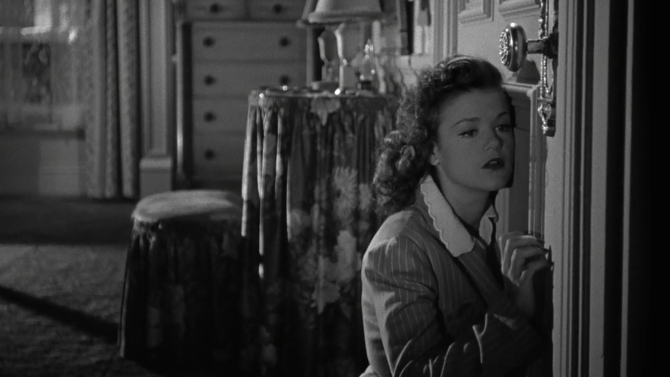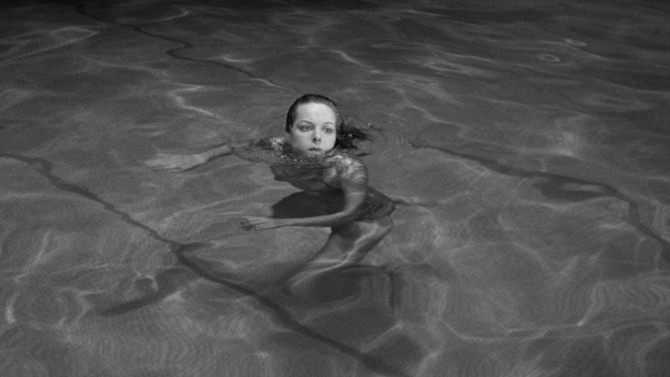In 1942, RKO Pictures set up a horror unit under producer Val Lewton, a former journalist, novelist and poet who had gone on to become a story editor for David O. Selznick. It was his job to develop low budget horror pictures for under 150,000 dollars, with the studio providing the titles for the films. His first task, the strangely named Cat People, almost seems like a joke.
A way for RKO to compete with the popular Universal horror films of the time, Lewton hired writer DeWitt Bodeen (I Remember Mama), director Jacques Tourneur (Out of the Past), cinematographer Nicholas Musuraca (I kid you not, both Out of the Past and I Remember Mama), and composer Roy Webb (Notorious, Marty) – a quality ensemble. And, Lewton supervised everything, the type of producer who would do re-writes on scripts, aid with editing and be involved in every other minute detail of the production process. In a unique twist, the films Lewton created with RKO have become synonymous with him and his distinct style, rather than the directors’, a rare occurrence to be sure.
Uniquely formed, it is very much a three part narrative, the first feeling like a romance, the second a drama, and the third a horror flick. The tale follows Irena Dubrovna (Simone Simon), a Serbian born fashion designer who just happens to meet Oliver Reed (Kent Smith), a marine engineer, while she is sketching a black panther at the Central Park Zoo in New York City.
Hitting it off, it does not take long for the two to fall in love, even after Irena divulges the ominous folkloric-sounding tale of her hometown, a location supposedly cursed by its sordid past. Enslaved by the Mameluks, her ancestors turned to witchcraft and devil worship, though most were slaughtered by King John of Serbia. Those who survived and fled to the mountains cursed those born in the village, something that she believes has inflicted her. Oliver, not taking too much notice of it, marries her.
Fearing that she will hurt the love of her life, Irena becomes more and more reclusive, not wanting to become too close to her husband, as the legend goes that she will turn into a giant cat when sexually aroused or angered – killing those she loves or loathes. But, by pushing him away, Oliver turns to co-worker Alice Moore (Jane Randolph) for comfort and moral support, spending more time with her as his wife’s condition worsens. Upon Alice’s recommendation, Oliver sends Irena to psychiatrist Dr. Louis Judd (Tom Conway), hoping that he will be able to help her through this extraordinary mind set.
As the film pushes towards its concluding notes, weird occurrences begin to happen. Is Irena actually a cat woman? Is there a reasonable explanation for the bizarre happenings? Will the doctor be able to help Irena? Will Irena and Oliver’s marriage survive?
What would be considered a micro-budgeted B movie, Lewton and his team, in a sense, aim for loftier goals with their film. Knowing that they could not match the Universal Picture horror films with effects and makeup (as they had less than six times the budget), they focussed on developing a more nuanced story and decided that less would be more, at least in the horror sense. Tourneur and cinematographer Musuraca utilize the camera, as well as harsh blacks and bright whites, and the shadows that fall within the milieu to add depth and suspense to their film. Unlike most monster movies, we never get much of a view of anything in this, shadow and light doing more for the mind than seeing a cheap, fake-looking prop on set.
A prime example of suspense comes from the famous bus sequence. As Jane is walking home, footsteps can be heard in the distance. Panicking, she quickens her pace. When the loud sound of her pursuer disappears, it frightens her even more. By fusing rich sound design, street lights which form intriguing shadows, and by using dolly shots, close-ups of her moving feet and static shots at opportune moments, the audience is wholly enveloped by the scene. Expecting a panther to jump out from any angle, the camera shows just her terrified face as a loud sound erupts from a swiftly stopping bus. . . an early example of a jump scare in a horror film. It became so famous that the technique was coined a ‘Lewton Bus’. And, though I will not go into the same detail, the swimming pool scene also deserves credit, another example of the thrills that can come from these aforementioned touches.
Also, for film buffs, the impressive staircase that leads to the Reed’s apartment may look familiar, as it is the one used in an earlier RKO film, Orson Welles’ 1942 drama, The Magnificent Ambersons. And for those history buffs, you may pick up that the pet cat at the ship designing firm is named John Paul Jones (the famed American Revolutionary War naval commander – not some premonition of the bassist/keyboardist from Led Zeppelin). Finally, for those Batman fans, Alan Napier (aka Alfred) has a small part as Doc Carver.
Though the studio was not overly pleased with the varied story that often lacked graphic horror elements, and critic reception was mixed (though, funnily enough, the movie ran in theatres so long that many critics saw the film again, re-writing their reviews to be more positive), audiences went to see the film in droves, and it grossed four million dollars in just two years, saving the studio from financial ruin. . . and, in retrospect, it has become known as a key, influential moment in the horror time-line – something many other studios and filmmakers would try to imitate, but could rarely duplicate. It catapulted everyone involved into the limelight (or back into it), and allowed for Lewton to make ten more films with the RKO unit. Cat People also spawned a 1982 remake which utilized the same title and starred Nastassja Kinski and Malcolm McDowell. So, make sure to pounce on this classic horror film, now celebrating its 75th anniversary, it will make a scaredy cat out of you.



